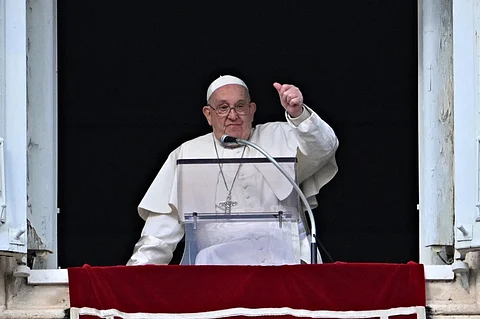
- NEWS
- the EDIT
- COMMENTARY
- BUSINESS
- LIFE
- SHOW
- ACTION
- GLOBAL GOALS
- SNAPS
- DYARYO TIRADA
- MORE

For Pope Francis — the son of Italian immigrants from Buenos Aires, a priest of the poor, and a spiritual shepherd to over 1.4 billion Catholics — 2025 began with silence. Frailty had begun to steal the strength that once carried him across continents. Yet, as ever, he met suffering with dignity, drawing the world into one final chapter of compassion, resilience, and unwavering faith.
The timeline that follows solemnly traces the quiet, poignant moments of his last days.
After presiding over his morning audiences, Pope Francis was rushed to Rome’s Gemelli Hospital with a respiratory tract infection and slight fever. Doctors soon diagnosed bronchitis, but beneath that simple term lay a far more complex threat. His condition would worsen in the days to come.
The Vatican confirmed a polymicrobial infection — bacterial, viral, and fungal — had taken hold of the pope’s respiratory passages. This marked the beginning of the most serious health crisis of his pontificate.
An X-ray revealed bilateral pneumonia, and doctors began administering antibiotics and cortisone. Though alert, Pope Francis was clearly deteriorating, raising concerns among medical staff and faithful alike.
Pope Francis suffered a severe respiratory episode, requiring high-pressure oxygen therapy. Doctors also administered two blood transfusions after signs of anemia and a low platelet count. The Vatican remained tight-lipped, but insiders whispered fears of sepsis — a dire threat for any patient, especially one with a history of lung surgery and at such an advanced age.
Doctors noted the onset of kidney insufficiency. While there was no repeat of the respiratory crisis, the pontiff remained in critical condition.
A glimmer of improvement arrived: his mild renal failure had begun to regress. It was the first good news in over a week, but caution still reigned.
During an isolated coughing fit, Francis inhaled vomit and required noninvasive aspiration. He was placed on a ventilator mask to stabilize his breathing. The prognosis remained guarded, but his medical team remained hopeful.
Two acute bronchospasms prompted emergency bronchoscopies. Despite the intensity of the procedures, the pope stayed alert and collaborative — a testament to his mental clarity amid physical weakness.
From his hospital bed, Francis recorded a breathless message to the faithful gathered in St. Peter’s Square. “Thank you,” he whispered. “Pray for me.” It was both a plea and a blessing.
Doctors declared Francis out of immediate danger from pneumonia. A chest X-ray on 12 March confirmed improvement. On 13 March, from his hospital bed, he quietly celebrated the 12th anniversary of his papacy — a papacy forged in humility and marked by unwavering advocacy for the poor.
The Vatican began reducing updates on his condition, signaling his gradual recovery. The silence was both relief and forewarning — a retreat from public life that felt final.
The first photograph of Pope Francis during his hospitalization was released: he sat, alone, before an altar in the chapel of the papal hospital apartment. No breathing tubes. Just a man in quiet prayer.
Doctors announced that Pope Francis would be released with strict instructions to rest for two months. On 23 March, a fragile figure emerged from Gemelli Hospital, waved from a balcony, and returned to the Vatican. His presence comforted the crowds, but it was clear — time was now a precious thing.
Despite doubts about his strength, Pope Francis appeared at the Easter Sunday celebration in St. Peter’s Square. Seated in a wheelchair and too weak to speak at length, he uttered “Happy Easter” with a fading voice. A collaborator read his address condemning violence in Gaza and rising antisemitism. It would be the last time the world saw him alive.
He met privately with U.S. Vice President JD Vance earlier that morning — a brief, symbolic encounter that closed the chapter on a long and sometimes turbulent dialogue between Francis and global powers.
Though he could no longer stand on the balcony, 35,000 people gathered to witness his presence. In his weakness, he gave the world one last gift: a moment of unity, reflection, and hope.
Pope Francis died peacefully at the age of 88. The world mourned the end of a papacy defined not by power, but by proximity — to the poor, to the forgotten, and to God.
Born Jorge Mario Bergoglio on 17 December 1936, Francis rose from the working-class neighborhood of Flores to the highest office in the Catholic Church. Ordained in 1969 and made a cardinal in 2001, he became the first Jesuit pope and the first from the Americas when elected in 2013.
He chose the name “Francis” to honor St. Francis of Assisi — a sign of the simplicity, humility, and advocacy that would define his papacy. From championing migrants and refugees to challenging global inequality and climate inaction, Pope Francis reshaped what leadership could look like in the 21st century.
His final days were a reflection of his life: rooted in faith, shrouded in compassion, and grounded in service.
“Even sick, we want to see him,” one pilgrim had said on Easter Sunday. And the world did. Just once more.
Now, the white cassock is empty. But the spirit of Pope Francis — humble, relentless, and deeply human — endures.
